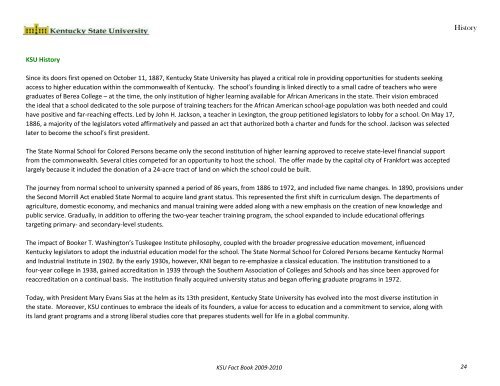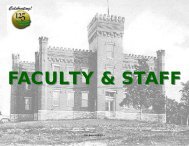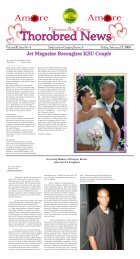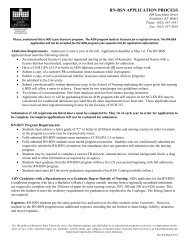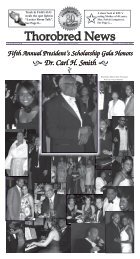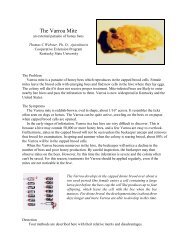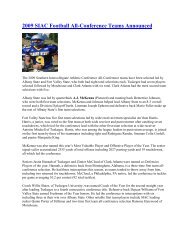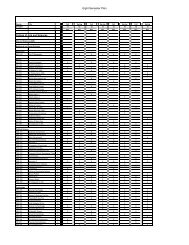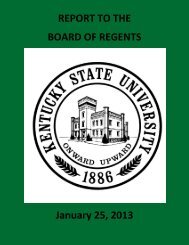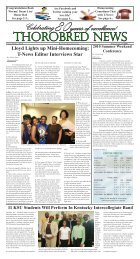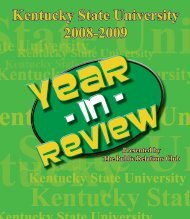Fact Book 2009-2010 - Kentucky State University
Fact Book 2009-2010 - Kentucky State University
Fact Book 2009-2010 - Kentucky State University
You also want an ePaper? Increase the reach of your titles
YUMPU automatically turns print PDFs into web optimized ePapers that Google loves.
HistoryKSU HistorySince its doors first opened on October 11, 1887, <strong>Kentucky</strong> <strong>State</strong> <strong>University</strong> has played a critical role in providing opportunities for students seekingaccess to higher education within the commonwealth of <strong>Kentucky</strong>. The school’s founding is linked directly to a small cadre of teachers who weregraduates of Berea College – at the time, the only institution of higher learning available for African Americans in the state. Their vision embracedthe ideal that a school dedicated to the sole purpose of training teachers for the African American school‐age population was both needed and couldhave positive and far‐reaching effects. Led by John H. Jackson, a teacher in Lexington, the group petitioned legislators to lobby for a school. On May 17,1886, a majority of the legislators voted affirmatively and passed an act that authorized both a charter and funds for the school. Jackson was selectedlater to become the school’s first president.The <strong>State</strong> Normal School for Colored Persons became only the second institution of higher learning approved to receive state‐level financial supportfrom the commonwealth. Several cities competed for an opportunity to host the school. The offer made by the capital city of Frankfort was acceptedlargely because it included the donation of a 24‐acre tract of land on which the school could be built.The journey from normal school to university spanned a period of 86 years, from 1886 to 1972, and included five name changes. In 1890, provisions underthe Second Morrill Act enabled <strong>State</strong> Normal to acquire land grant status. This represented the first shift in curriculum design. The departments ofagriculture, domestic economy, and mechanics and manual training were added along with a new emphasis on the creation of new knowledge andpublic service. Gradually, in addition to offering the two‐year teacher training program, the school expanded to include educational offeringstargeting primary‐ and secondary‐level students.The impact of <strong>Book</strong>er T. Washington’s Tuskegee Institute philosophy, coupled with the broader progressive education movement, influenced<strong>Kentucky</strong> legislators to adopt the industrial education model for the school. The <strong>State</strong> Normal School for Colored Persons became <strong>Kentucky</strong> Normaland Industrial Institute in 1902. By the early 1930s, however, KNII began to re‐emphasize a classical education. The institution transitioned to afour‐year college in 1938, gained accreditation in 1939 through the Southern Association of Colleges and Schools and has since been approved forreaccreditation on a continual basis. The institution finally acquired university status and began offering graduate programs in 1972.Today, with President Mary Evans Sias at the helm as its 13th president, <strong>Kentucky</strong> <strong>State</strong> <strong>University</strong> has evolved into the most diverse institution inthe state. Moreover, KSU continues to embrace the ideals of its founders, a value for access to education and a commitment to service, along withits land grant programs and a strong liberal studies core that prepares students well for life in a global community.KSU <strong>Fact</strong> <strong>Book</strong> <strong>2009</strong>‐<strong>2010</strong> 24


